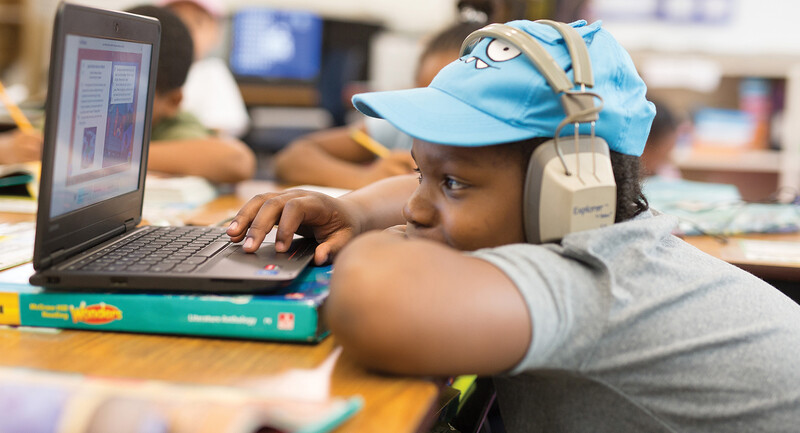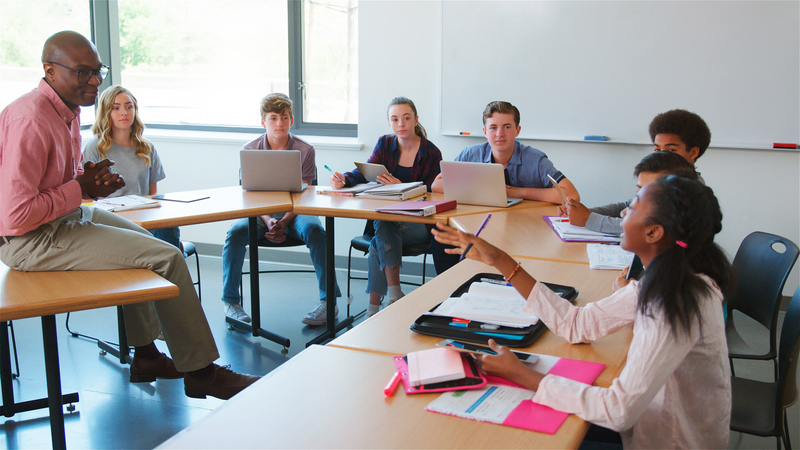As school leaders, we often hear about challenges that our educators and staff face with technology—particularly with implementing new tools, troubleshooting technology, and figuring out best practices to use edtech in their classrooms. But we can forget to consider the challenges, experiences, and frustrations that our students face with technology.
Depending on grade level, familiarity with technology, and academic subject, students, too, are at varying levels of comfort using devices and platforms. Unfortunately, this can also mean that students are frustrated with the ways that we address technology as educators and school leaders. They enter our schools with a variety of experiences with technology. You may have students that lack internet access and have very limited experience with technology, and you may have students with multiple devices and unlimited screen time. You may have students who use technology to complete academic tasks, explore new and difficult concepts, learn more about what they're interested in, and connect with their peers. And you may have students who only use technology for academic purposes.
Educators need to take all this into account. Just as we would not assume that students have prior knowledge of any subject we are teaching, we cannot assume they have knowledge of and experience with technology. So we cannot offer up a video platform to students and essentially say, "Figure it out." I wouldn't put any piece of technology in front of anyone without first experimenting with it myself, because I not only want to know how the technology works, but also how I can best provide support to students if they have questions about using it. If I don't know, my students will feel lost or frustrated. They may come to me with questions that I can't answer. Worst case of all, they may get so overwhelmed with the tool, or the prospect of asking questions about how to use the tool, that they just give up.
The Struggle Is Real
I recently observed a group of high school students who were expected to complete a 15-minute video project for a school showcase of student learning—essentially a night where they invited their families and peers to see various projects, activities, and videos that they had created to show what they had learned throughout the year. The students had the opportunity to submit the videos to a districtwide contest for a chance to win a local scholarship for college, given by a business in the area. So the stakes were high, and the students were very excited.
The educator in charge of the project assumed that since the students had experience watching videos on platforms like YouTube and TikTok, they would be able to jump right into making and editing the videos. That was not the case. Although the students watched videos, and at times created small one-minute videos to share with their friends, they did not have the skillset to create a 15-minute piece of media that was going to be viewed, graded, and perhaps judged on a much larger scale.
The educator provided no structure for how the videos should be created and submitted, and very little support. In fact, the educator later admitted to me that they did not do research on the video platform before giving it to the students, so they couldn't answer the questions students had as they were attempting to work on the project. It wasn't that the educator didn't have the time (as is sometimes the case) to do research on the platform; the educator thought that the students would just be able to handle it. But the students were confused and, frankly, angry about the process.
The project did get completed—but not without challenges and frustrations that could have been avoided with even a little bit of planning and preparation.
We must first understand some of the challenges that our students are encountering with technology.
Teachers need to be supported in their technology use in the classroom, but in order to make sure that support is effective, we must first understand some of the challenges our students are likely to encounter with technology. When we address some roots of the challenges, we can find ways to problem solve as a school community.
They Don't Know It All
Below are four main technology-related challenges for students I have seen in my work with schools, along with suggestions for how teachers and school leaders can help overcome them.
1. Teachers assume all students are "digital natives" and may not give enough scaffolding and support for new technology tools.
I was a kid when landlines and dial-up internet still existed at work and school. Then technology advanced rapidly with smart phones and other devices when I was in high school. I was labeled a "digital native" because I came of age during a large technology revolution of touchscreens and mobile devices, even though I'm still learning new things about technology every single day. The same is true for our students. Just because a student grows up surrounded by various pieces of technology doesn't mean that they automatically know how to use any technology—especially if the technology is new to them. Students still need scaffolding, support, and time to experiment with technology tools to use them to showcase their learning.
This will look different depending on school environment, devices, and platforms that may be available, a student's comfort level with technology, and what the technology is being used for (among other things). But regardless, students need assistance with planning, problem solving, and creating with technology.
2. Students spend a lot of their time online, which can lead to technology burnout.
Students can experience "technology burnout," the same way that adults sometimes struggle with being on devices for a long time. I once observed a grade level where, for the full seven hours of in-person schooling, every teacher used the same educational technology platform to teach their lessons, have students work collaboratively with their peers, and administer summative assessments/exit checks. Students were on their computers from the moment they entered each classroom to the moment they exited each classroom. By the middle of the day, the students were burnt out. They had had no variety and were bored from using the same platform day in and day out.
I suggested that the team examine other platforms that could be used to deliver the content and also to limit the use of that specific platform to one period per class per week. My recommendation was not necessarily to use less technology, but rather to be more varied with the way teachers used it to deliver content, create assignments, and have students complete assignments. Student engagement in that grade level immediately went up, and students reported being happier with the new variety in tech tools.
3. Teachers aren't providing enough robust instruction with technology.
Because students have spent more of their time online both in and out of school, they expect to work with the technology, not just passively use it. I have friends whose children say they prefer virtual school or homeschooling because they feel the delivery of the content in their in-person school seems nearly identical to what they were doing when they were virtual—they log in every day, they have initial check-in time with their teachers, then they go on a learning management system to complete their assignments and turn everything in online. There seems to be very little collaboration with their peers, very little interaction with their teachers, and no opportunities for students to be creative.
That was very unfortunate to hear, and it's absolutely not the way we want to use technology in our school communities. Technology should enhance learning and collaboration and be used for things like project creation with multimedia platforms, essay writing, and social-emotional check-ins. When we move past the more shallow ways of using tech and toward deeper creation, students can really see the opportunities that technology provides for deepening their learning experiences.
4. Students are eager to use technology in innovative ways to showcase their learning, but are sometimes given limited opportunities to do so.
"Showcase" is the most important piece here; when students can use technology to demonstrate what they've done and create new learning experiences for themselves, we've transformed it to define and demonstrate learning. Traditional ways to showcase learning (such as trifolds, poster boards, and science fair projects) can seem outdated in the context of today's technology. Additionally, learning showcases are often regulated to certain times of the year, which gives students only certain time frames to show what they've accomplished. Given more time and support to use technology creatively, students can create videos, dynamic portfolios, multimedia presentations, items with 3D printers, and more—and these tools offer more flexibility for showcasing learning more often throughout the year.
Leadership Strategies
In light of these challenges, here are three strategies that can help school leaders take student learning to the next level by using technology.
School leaders can shape technology use on campus so that the whole school has a consistent approach that improves outcomes for students.
Establish yourself as a technology leader. School leaders can shape technology use on campus so that the whole school has a consistent approach that improves outcomes for students. They can ask good questions to get to the heart of student and teacher technology needs.
Do teachers need more support with technology implementation? If so, you may need to create technology-learning communities or time during faculty meetings to address challenges. Do students want more opportunity to give anonymous feedback to their teachers? If so, you may need to lead (or find a faculty or staff member to lead) a small professional development session on using technology for feedback and insights. Do your colleagues need assistance with using technology for assessment? If so, you may need to look into which assessment tools can help your teachers assess formatively and summatively in the classroom. All of these and more can be addressed from a leadership standpoint, and technology can also help you address these points.
As a first step toward becoming a technology leader, I recommend school leaders actually use the technology that their educators employ in their classrooms. Yes, this might seem obvious, but many school leaders do not do this! During faculty or staff meetings, department meetings, or district meetings, find creative ways to incorporate the tools your teachers are using. An example of this may be, at the beginning of the year, using a platform like Kahoot! or Quizizz for a "back to school" game through which faculty and staff review school policies, procedures, and pertinent staff information (such as when to arrive, when school dismissal is, general behavior procedures, school dress code, and protocol for family-teacher conferences). When educators see you using what they use, it helps you build credibility among your faculty and staff, and they may feel more inclined to speak with you about how they use technology, too.
Identify technology leaders within your student body and use their feedback to identify areas of strength and weakness in your school. Students can not only help other students with technology solutions, they can also bring to light what technology usage looks like in classrooms from their perspective. Create a technology professional learning community, where students can discuss the technology they've used, what they have and haven't enjoyed, and answer questions. Incorporate their feedback into schoolwide faculty and administrative meetings to identify areas of strength and weakness in your school regarding technology usage.
Make it a mission to proactively avoid "technology burnout" in your school. Technology usage in school communities should be intentional and purposeful, but shouldn't overwhelm people. As a leader, think about how you'd like to use technology to achieve your school community goals and put steps in place so that you can get started. Initial questions to ask include:
How can technology support innovation at our school?
How do I want my teachers and students to be using technology?
How can I model best practices as an administrator?
How often should educators be using certain tools in the classroom?
When you're tackling technology burnout, this is also a wonderful opportunity to leverage your student technology learning community. You, your faculty, and your staff may have ideas on how technology can help achieve your school's goals, but students may have different opinions. Make it a point to ask these questions directly (with student-friendly language) and receive their feedback. Once you've got their insight, you can begin to work with your educators to address strategies that can help with technology burnout. Here are some suggestions:
Survey faculty, staff, and students to see which technology tools they use in the classroom and at school daily, frequently (two to three times a week), or rarely (less than once a week). Which tools do students like best?
If faculty members on the same team are consistently using the same technology tools, suggest exploring different tools.
Make it a routine practice (at least once per quarter) for educators to observe other teachers using technology with their students. Observations can help lead to new ideas and new ways to use edtech in their own classrooms.
When we step back and take a closer look at the way our students experience and use technology and the challenges they might face, we can create support and solutions to positively impact our students and school communities. Supporting our students in the journey of technology transition is just as important as supporting our faculty and staff.








